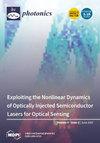Analyses of an Ultra-Wideband Absorber from UV-B to Middle-IR Utilizing a Square Nanopillar and a Square Hollow Embedded in a Square Cavity of the Top Layer of Multilayer Metamaterials
IF 2.1
4区 物理与天体物理
Q2 OPTICS
引用次数: 0
Abstract
In this study, an ultra-wideband absorber spanning from UV-B to middle-IR was designed and analyzed using a novel structure. The multilayer metamaterial, arranged from bottom to top, consisted of an Al metal layer, a lower SiO2 layer, a graphite layer, another SiO2 layer, a thin Ti layer, and a top SiO2 layer. The top layer of SiO2 had a 200 nm square cavity etched out, and then a square Ti nanopillar and a square Ti hollow outside a Ti nanopillar were embedded. This specific arrangement was chosen to maximize the absorption properties across a broad spectrum. The absorption spectrum of the designed absorber was thoroughly analyzed using the commercial finite element analysis software COMSOL Multiphysics® (version 6.0). This analysis confirmed that the combination of these various components achieved perfect absorption and an ultra-wideband response. The synergistic interaction between the layers and the nanopillars structure contributed significantly to the absorber’s efficiency, making it a promising candidate for applications requiring broad-spectrum absorption. The comprehensive analyses of the parameters for different structures demonstrated that the effects of guided-mode resonance, coupling resonance, optical impedance matching, and propagating surface plasmon resonance existed in the investigated structure. The optimal model, determined through analyses using COMSOL Multiphysics®, showed that the broadband absorption in the range of 270 to 3600 nm, spanning from UV-B to middle-IR, exceeded 90.0%. The average absorption rate within this range was 0.967, with the highest reaching a near-perfect absorptivity of 99.9%. We also compared three absorption spectra in this study: the t1–t6 flat structure, the t1–t5 flat structure with t6 featuring a square cavity, and the structure proposed in this study. This demonstrates that a square nanopillar and a square hollow embedded in a square cavity can enhance the absorptive properties of the absorber.利用多层超材料顶层方形空腔中嵌入的方形纳米柱和方形空心,分析从紫外线-B 到中红外线的超宽带吸收器
本研究利用一种新型结构设计并分析了从紫外线-B 到中红外线的超宽带吸收器。这种多层超材料从下到上依次为铝金属层、下层二氧化硅层、石墨层、另一层二氧化硅层、薄钛层和顶层二氧化硅层。二氧化硅顶层蚀刻出一个 200 纳米的正方形空腔,然后嵌入一个正方形钛纳米柱和一个钛纳米柱外的正方形钛空腔。选择这种特定的排列方式是为了最大限度地提高宽光谱的吸收特性。使用商用有限元分析软件 COMSOL Multiphysics®(6.0 版)对所设计吸收器的吸收光谱进行了全面分析。分析结果证实,这些不同组件的组合实现了完美的吸收和超宽带响应。各层和纳米柱结构之间的协同作用大大提高了吸收器的效率,使其成为需要广谱吸收应用的理想候选材料。对不同结构参数的综合分析表明,所研究的结构中存在导模共振、耦合共振、光阻抗匹配和传播表面等离子体共振效应。通过使用 COMSOL Multiphysics® 进行分析而确定的最佳模型显示,从紫外线-B 到中红外线,270 纳米到 3600 纳米范围内的宽带吸收率超过 90.0%。该范围内的平均吸收率为 0.967,最高吸收率接近 99.9%。在这项研究中,我们还比较了三种吸收光谱:t1-t6 扁平结构、t1-t5 扁平结构(其中 t6 为方形空腔)和本研究提出的结构。这表明,方形纳米柱和嵌入方形空腔的方形空心可以增强吸收器的吸收特性。
本文章由计算机程序翻译,如有差异,请以英文原文为准。
求助全文
约1分钟内获得全文
求助全文
来源期刊

Photonics
Physics and Astronomy-Instrumentation
CiteScore
2.60
自引率
20.80%
发文量
817
审稿时长
8 weeks
期刊介绍:
Photonics (ISSN 2304-6732) aims at a fast turn around time for peer-reviewing manuscripts and producing accepted articles. The online-only and open access nature of the journal will allow for a speedy and wide circulation of your research as well as review articles. We aim at establishing Photonics as a leading venue for publishing high impact fundamental research but also applications of optics and photonics. The journal particularly welcomes both theoretical (simulation) and experimental research. Our aim is to encourage scientists to publish their experimental and theoretical results in as much detail as possible. There is no restriction on the length of the papers. The full experimental details must be provided so that the results can be reproduced. Electronic files and software regarding the full details of the calculation and experimental procedure, if unable to be published in a normal way, can be deposited as supplementary material.
 求助内容:
求助内容: 应助结果提醒方式:
应助结果提醒方式:


